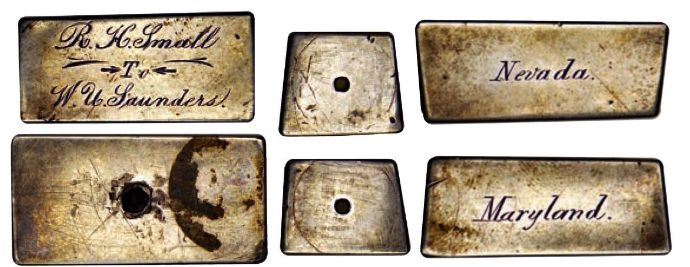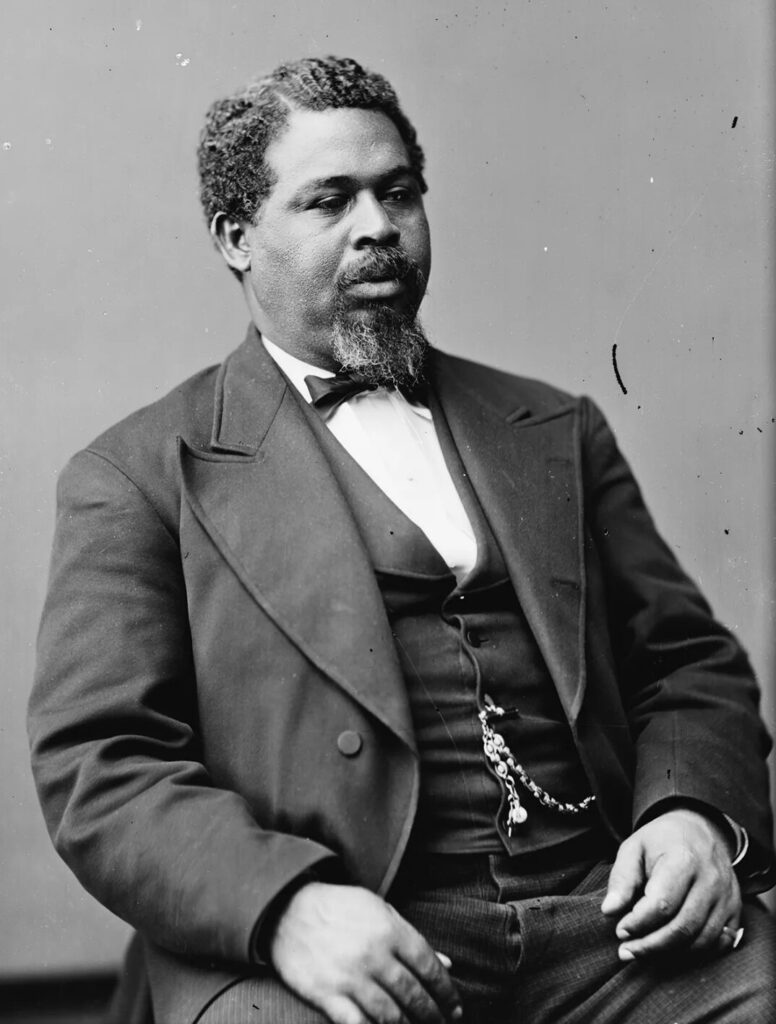Incredible African-American Historical Ingot Presented to Mark the 1869 Colored National Labor Convention

Nevada. Treasure Hill. Silver.
19.0 mm x 37.8 mm x 15.2 mm. Unmarked for weight and fineness. 98.0 grams, 3.15 troy ounces. A somewhat austere looking trapezoidal form ingot, engraved on the top face “R.H. Small To W.U. Saunders.” The right and left end faces are plain but for neat circular indentations which once tied to this piece to some manner of display. The bottom face shows a deeper circular drill mark that served the same purpose. The north face is engraved “Nevada” while the south face is engraved “Maryland.” The surfaces are brilliant from polishing and show just the merest gathered toning. Upon first glance, this ingot could hardly purport to summarize a remarkable tale of friendship between two highly influential free black men and their work towards the passage of the 15th Amendment, which guaranteed the right to vote to every American (male) citizen. Robert H. Small moved west at the beginning of the 1860s, finding a home for his family and work for himself near Placerville, CA. At the end of the decade, after years of important work and activism in the African-American community, he found his way to Nevada in 1869. Drawn by the politically active African-American newspaper The Elevator, Small settled in Treasure Hill, a mining town with a substantial African-American population. He continued his activism, oration, and work on behalf of the African-American community. Nevada was fertile ground for such work. Though it had been a state for fewer than five years, Nevada was the first state in the Union to ratify the 15th Amendment in March 1869. The same year, Washington DC played host to the first Colored National Labor Convention, a national effort to assist working African-Americans find their way in Reconstruction-era America.
Robert Small
the 1860s, Robert Smalls was a key figure during the Civil War and the Reconstruction era. He is best known for his daring escape from slavery in 1862, stealing the Confederate steamer Planter and delivering it to Union forces. He later served as a Union Navy pilot and captain. His actions and subsequent career made him a significant figure in the fight for civil rights and representation for Black Americans. He later became the first Black captain of a vessel in U.S. service. He served multiple terms (1875–79, 1882–83, and 1884–87) as a congressman from South Carolina.

Robert H. Small moved west at the beginning of the 1860s, finding a home for his family and work for himself near Placerville, CA. At the end of the decade, after years of important work and activism in the African-American community, he found his way to Nevada in 1869. Drawn by the politically active African-American newspaper The Elevator, Small settled in Treasure Hill, a mining town with a substantial African-American population. He continued his activism, oration, and work on behalf of the African-American community. Nevada was fertile ground for such work. Though it had been a state for fewer than five years, Nevada was the first state in the Union to ratify the 15th Amendment in March 1869. The same year, Washington DC played host to the first Colored National Labor Convention, a national effort to assist working African-Americans find their way in Reconstruction-era America.
William Hall
Despite Nevada’s leadership role in national African-American affairs, when the hundreds of delegates were invited from all across the county, just one was invited from Nevada: Robert H. Small. He was one of but two representatives from the West. The other was William Hall, an executive of the Elevator Mining Company in Treasure Hill, Nevada, named for the influential newspaper that had played such a role in Small’s career. Travel from the West Coast was difficult. Both representatives from the Western states had to find surrogates to represent them. Small asked an old friend from Maryland, William U. Saunders, then working as a Post Office inspector in Baltimore. A trained lawyer and onetime Congressional candidate during the initial Reconstruction government of Florida, Saunders was the equal of Small in the African-American activist community.
He took on a leadership role at the Colored National Labor Convention. This little ingot was a token of Small’s appreciation to Saunders for representing Nevada at the Convention. Undoubtedly made from a dollop of Treasure Hill silver, it was discovered in Maryland in recent years. Its significance was only recently realized. Small stayed in Nevada just a few more years, remaining a high profile activist for the rights of African-Americans during Reconstruction. He lived out his final years in Sacramento, where he worked as a barber. Saunders returned to Florida and worked as an attorney, Customs official, and U.S. Marshall. These two heroes of Reconstruction would have likely remained largely forgotten but for this ingot, presented to repay a favor nearly 150 years ago.
[07/2009] https://nnp.wustl.edu/library/auctionlots?AucCoId=3&AuctionId=517017 ($19,550) Page 215, Lot 1200
[07/2009] https://auctions.stacksbowers.com/lots/view/3-B2LGU/nevada-treasure-hill-silver
Brasher Bulletin Article: https://archive.org/details/brasherbulletin2008soci_r9h4/page/8/
